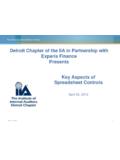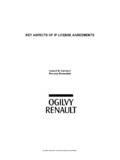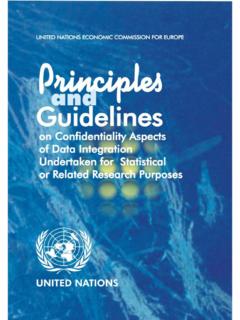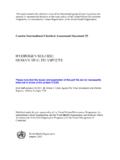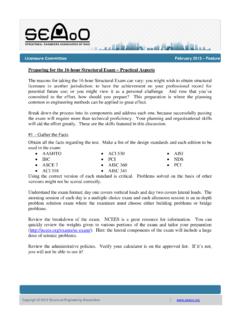Transcription of A Synthesis of International Regulatory Aspects …
1 September 2012 Agriculture plays a fundamental role in meeting the world s growing demand for food, feed and fibre. Farmers worldwide will have to produce more food in a sustainable way and with fewer resources; and access to high quality seed is an important factor in facing these challenges. To strengthen the seed sector it is essential that seed producers adhere to policies that guarantee quality standards and appropriate Regulatory features. A functioning Regulatory framework helps to promote competitive seed markets and lowers trade barriers, thereby providing a better choice of quality seed for farmers. This document reviews Regulatory Aspects related to the seed trade and the role of International organisations in trade harmonisation and the establishment of International standards. Special attention is paid to the OECD Seed Schemes and their contribution to the development of an International seed certification framework.
2 The document discusses seed certification, seed testing and phytosanitary measures. It also sheds light on plant variety protection, capacity building at the International level and International rules for seed trade and arbitration. OECD SEED A Synthesis of International Regulatory Aspects that Affect Seed Trade 1 TABLE OF CONTENTS LIST OF ABBREVIATIONS .. 2 I. INTRODUCTION .. 3 II. SEED CERTIFICATION .. 4 The OECD Seed Schemes: A globally recognized seed certification system .. 4 Other seed certification systems .. 5 III. SEED TESTING .. 6 The International Seed Testing Association .. 6 Other seed testing organisations .. 7 IV. PHYTOSANITARY MEASURES .. 8 Sanitary and Phytosanitary Agreement (SPS) .. 8 Harmonization of phytosanitary regulations .. 8 V. PLANT VARIETY PROTECTION .. 9 Plant Variety Protection (PVP) and UPOV .. 9 Exchange of germplasm and the International Treaty on Plant Genetic Resources for Food and Agriculture.
3 10 VI. CAPACITY BUILDING AT THE International LEVEL .. 11 VII. International RULES FOR TRADE AND ARBITRATION .. 12 VIII. CONCLUDING REMARKS .. 13 ANNEX 1 .. 14 ANNEX 2 .. 15 2 LIST OF ABBREVIATIONS AOSA Association of Official Seed Analysts AOSCA Association of Official Seed Certifying Agencies CEMAC Communaute Economique et Monetaire de l Afrique Centrale ECOWAS Economic Community of West African States EU European Union FAO Food and Agriculture Organization of the United Nations GIPB Global Partnership Initiative for Plant Breeding Capacity Building GPA Global Plan of Action IP Identity Preserved IPPC International Plant Protection Convention ISF International Seed Federation ISTA International Seed Testing Association MLS Multilateral System of Access and Benefit-Sharing NDA National Designated Authority OAPI Organisation africaine de la propri t intellectuelle OECD Organisation for Economic Co-operation and Development OIC Orange International Seed Lot Certificate PGRFA Plant Genetic Resources for Food and Agriculture QA Quality Assurance QDS Quality Declared Seed RPPO
4 Regional Plant Protection Organization SADC Southern African Development Community SMTA Standard Material Transfer Agreement SPS Sanitary and Phytosanitary TRIPS Trade-Related Aspects of Intellectual Property Rights UPOV International Union for the Protection of New Varieties of Plants WTO World Trade Organization 3 I. INTRODUCTION 1. World population will increase from billion in 2010 to billion people in 2050; and agriculture will play a fundamental role in meeting the world s growing demand for food, feed and fibre. In order to feed the world population in 2050, agricultural production will have to almost double, and most of the incremental output will have to come from increases in yields (FAO, 2009).1 2. High-quality seed is a pre-requisite to achieve maximum outputs and good returns for farmers. In many countries crop production and seed trade are also important sources of rural employment and foreign income.
5 In 2011, the commercial world seed market was valued at US$ 42 billion, and the value of internationally traded seed was estimated at US$ billion in 2010 (ISF, 2011).2 3. To strengthen the seed sector, it is crucial that seed growers and companies adhere to policies that guarantee quality standards and appropriate Regulatory features. Many countries have adopted seed laws. Standards differ, but considerable efforts have been and continue to be made to harmonize national seed laws and seed trade regulations. 4. A number of International organisations, conventions and treaties deal with the regulation of seed trade, ranging from access to delivery of quality seeds to growers. Together they provide an International Regulatory framework by overseeing the interests of breeders, producers and consumers. Among these organisations are the Organisation for Economic Co-operation and Development (OECD), whose Seed Schemes are globally recognized for the certification of seed moving in International trade.
6 The International Seed Testing Association (ISTA) developed globally recognised standard procedures for seed sampling and testing. The International Union for the Protection of New Varieties of Plants (UPOV) provides breeders of new plant varieties with an intellectual property protection. The International Seed Federation (ISF) provides seed companies with trade and arbitration rules. Besides, there are the International conventions and treaties hosted by the Food and Agriculture Organization of the United Nations (FAO) that provide the International Regulatory framework for related Aspects of seed trade, including plant health and phytosanitary measures, access and benefit-sharing for plant germplasm and use of pesticides. Annex 1 provides a schematic overview of the different Regulatory systems and actors in the seed supply chain. 5. An appropriate Regulatory framework helps to promote competitive seed markets and lowers barriers to trade.
7 This paper discusses Regulatory Aspects related to seed trade and the role of International organisations in trade harmonisation and the establishment of International standards. Special attention is paid to the OECD Seed Schemes and their contribution to the development of an International seed certification framework as well as their links to other International organisations. 6. This paper corresponds to the strategic plan of the OECD Seed Schemes. The plan aims to further strengthen the work of the Schemes and its value to Member countries. To achieve this goal, five key strategic areas are defined. Strategic area C, for example, is to enhance policy awareness through better linkages to seed related issues. Within each strategic area, different objectives are defined to achieve the strategic goal. This paper contributes to the objective of providing a better understanding of the impacts of the harmonisation of seed standards and regulations on International trade through specific research studies , within strategic area C.
8 1 FAO (2009), High-Level Expert Forum on How to Feed the World in 2050, Rome, 12-13 October. 2 ISF (2011), Seed Statistics. Available at: 4 7. This document is intended as an information document for policy-makers in Member countries of the OECD Seed Schemes and in countries interested in joining the Schemes. Additionally, it could serve as an educational tool for new participants in the Schemes. 8. The paper proceeds as follows: Section II provides an overview on seed certification; Section III discusses Aspects of seed testing, and section IV reviews phytosanitary measures. Section V sheds light on plant variety protection. Section VI discusses capacity building at the International level, while section VII looks at International rules for trade and arbitration. Section VIII concludes. II. SEED CERTIFICATION 9. Seed certification is a quality assurance process.
9 Seed intended for domestic or International markets is controlled and inspected by official sources in order to guarantee consistent high quality for consumers. This is done by i) controlling the seed in previous generations; ii) carrying out field inspections during the multiplication process to ensure there is little contamination and that the variety is true to type; iii) growing samples in control plots of the known seed to ensure that the progeny conform to the characteristics of the variety and iv) seed quality testing in laboratories. 10. Of all the Regulatory standards relating to seed laws, certification probably varies the most between different countries and parts of the world. Almost all countries developed their own certification standards (some have accepted the OECD Seed Schemes Rules as their national standards). In some countries certification is obligatory and in others optional.
10 Some certification schemes focus on the genetic characteristics; in others, varietal certification is complemented by tests carried out in order to check laboratory standards, such as minimum germination, minimum analytical purity and seed health. The OECD Seed Schemes: A globally recognized seed certification system 11. The OECD Seed Schemes provide an International framework for the certification of seed. They aim to facilitate seed trade by reducing technical barriers, improving transparency and lowering transactions costs. The OECD Seed Schemes were set up in 1958 with the objective to encourage the use of seed of consistently high quality in participating countries. There are currently 58 Members of one or more of the OECD Seed Schemes worldwide. 12. The Seed Schemes authorise the use of labels and certificates for seed produced and processed for International trade according to agreed principles.










